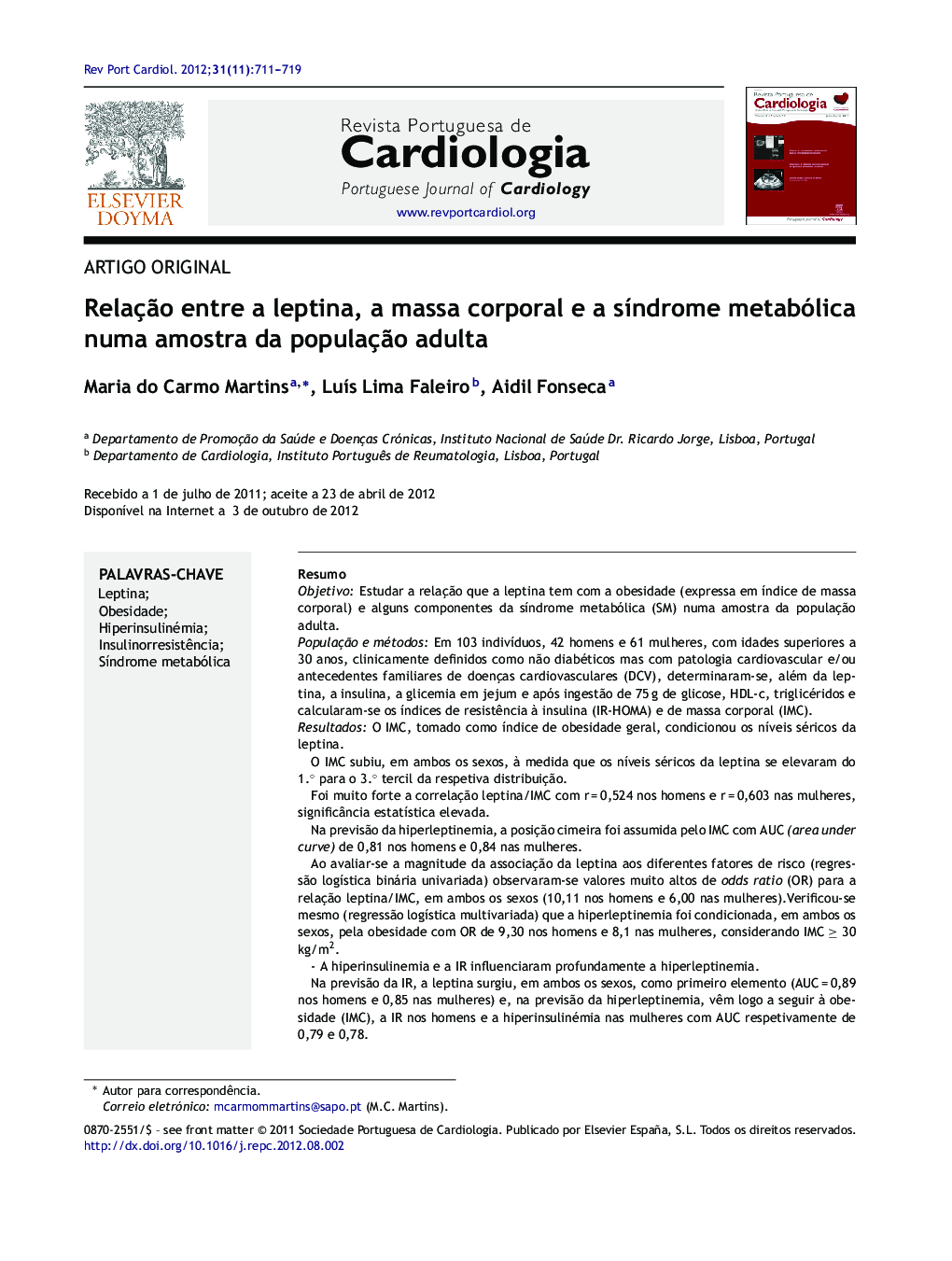| Article ID | Journal | Published Year | Pages | File Type |
|---|---|---|---|---|
| 1126279 | Revista Portuguesa de Cardiologia | 2012 | 9 Pages |
ResumoObjetivoEstudar a relação que a leptina tem com a obesidade (expressa em índice de massa corporal) e alguns componentes da síndrome metabólica (SM) numa amostra da população adulta.População e métodosEm 103 indivíduos, 42 homens e 61 mulheres, com idades superiores a 30 anos, clinicamente definidos como não diabéticos mas com patologia cardiovascular e/ou antecedentes familiares de doenças cardiovasculares (DCV), determinaram-se, além da leptina, a insulina, a glicemia em jejum e após ingestão de 75 g de glicose, HDL-c, triglicéridos e calcularam-se os índices de resistência à insulina (IR-HOMA) e de massa corporal (IMC).ResultadosO IMC, tomado como índice de obesidade geral, condicionou os níveis séricos da leptina.O IMC subiu, em ambos os sexos, à medida que os níveis séricos da leptina se elevaram do 1.° para o 3.° tercil da respetiva distribuição.Foi muito forte a correlação leptina/IMC com r = 0,524 nos homens e r = 0,603 nas mulheres, significância estatística elevada.Na previsão da hiperleptinemia, a posição cimeira foi assumida pelo IMC com AUC (area under curve) de 0,81 nos homens e 0,84 nas mulheres.Ao avaliar-se a magnitude da associação da leptina aos diferentes fatores de risco (regressão logística binária univariada) observaram-se valores muito altos de odds ratio (OR) para a relação leptina/IMC, em ambos os sexos (10,11 nos homens e 6,00 nas mulheres).Verificou-se mesmo (regressão logística multivariada) que a hiperleptinemia foi condicionada, em ambos os sexos, pela obesidade com OR de 9,30 nos homens e 8,1 nas mulheres, considerando IMC ≥ 30 kg/m2.- A hiperinsulinemia e a IR influenciaram profundamente a hiperleptinemia.Na previsão da IR, a leptina surgiu, em ambos os sexos, como primeiro elemento (AUC = 0,89 nos homens e 0,85 nas mulheres) e, na previsão da hiperleptinemia, vêm logo a seguir à obesidade (IMC), a IR nos homens e a hiperinsulinémia nas mulheres com AUC respetivamente de 0,79 e 0,78.Foram fortes as correlações leptina/IR-HOMA e leptina/insulina, em ambos os sexos e enorme a influência que nos homens teve a hiperinsulinémia (OR = 11,71) e a IR nas mulheres (OR = 21,22).- Relativamente aos componentes da SM:Observou-se elevação dos respetivos níveis séricos, à medida que as concentrações da leptina subiram do 1.° para o 3.° tercil da respetiva distribuição (com exceção do HDL-c, que desceu).ConclusãoO aumento da leptina sérica, sobretudo nos indivíduos obesos, deve constituir sinal de alerta para desiquilíbrios energéticos e do regimen alimentar, para a existência de hiperinsulinemia, de IR, de alterações em outros fatores de risco metabólicos que têm profunda influência nas DCV e diabetes tipo 2.
ObjectiveTo analyze the relationship between leptin and obesity expressed as body mass index (BMI) and certain components of the metabolic syndrome (MS) in an adult population.MethodsThe study included 103 subjects, 42 men and 61 women, aged over 30 years, clinically defined as non-diabetic but with personal or family history of cardiovascular disease. All subjects underwent fasting blood measurements of leptin, insulin, glucose, glucose after ingestion of 75 g glucose, HDL cholesterol and triglycerides, and insulin resistance (IR) and BMI were calculated.ResultsBMI as an index of overall adiposity was strongly associated with serum leptin. BMI rose as serum leptin levels increased from the first to the third tertile; the correlation between leptin and BMI was strong, r = 0.524 in men and r = 0.603 in women, with high statistical significance (p < 0.001); BMI was the best predictor of hyperleptinemia on ROC analysis, with area under the curve (AUC) = 0.81 in men and 0.84 in women.The association between leptin and obesity (BMI ≥30 kg/m2) showed high odds ratios (OR) in both sexes (10.11 in men, 6.00 in women) on univariate regression analysis and 9.30 in men and 8.21 in women on multivariate regression analysis.Hyperinsulinemia and IR strongly influenced hyperleptinemia. Leptin was the best predictor of IR in both sexes (AUC = 0.89 in men and 0.85 in women), and IR in men (AUC = 0.79) and hyperinsulinemia in women (AUC = 0.78) were the best predictors of hyperleptinemia after BMI. The correlations between leptin and IR, and leptin and insulinemia, were strong in both sexes.With regard to MS components, increased serum levels of the study variables were observed as leptin concentrations rose from the first to the third tertile (with the exception of HDL cholesterol, which decreased).ConclusionElevated serum leptin, particularly in obese individuals, should be taken as a warning sign of energy imbalance, poor diet, hyperinsulinemia, insulin resistance, or changes in other metabolic risk factors that are strongly associated with cardiovascular disease and type 2 diabetes.
